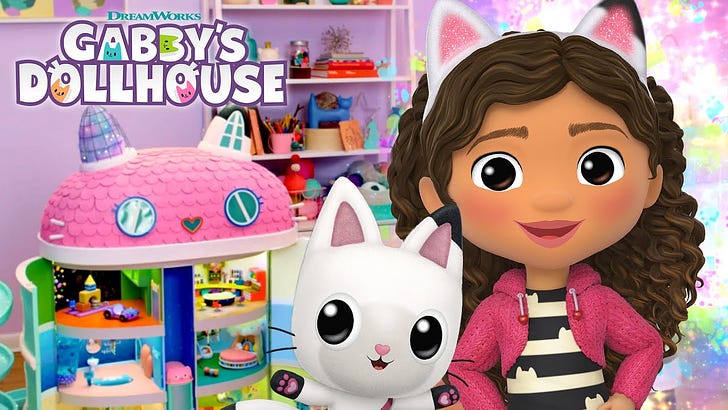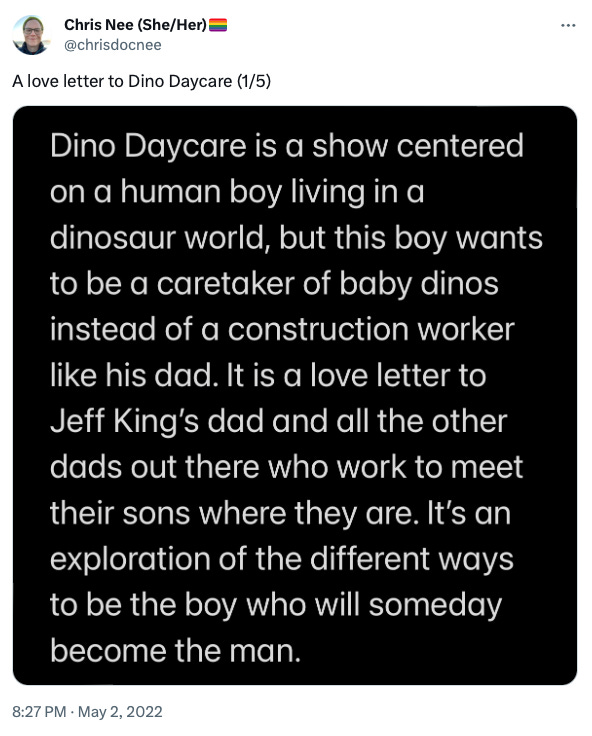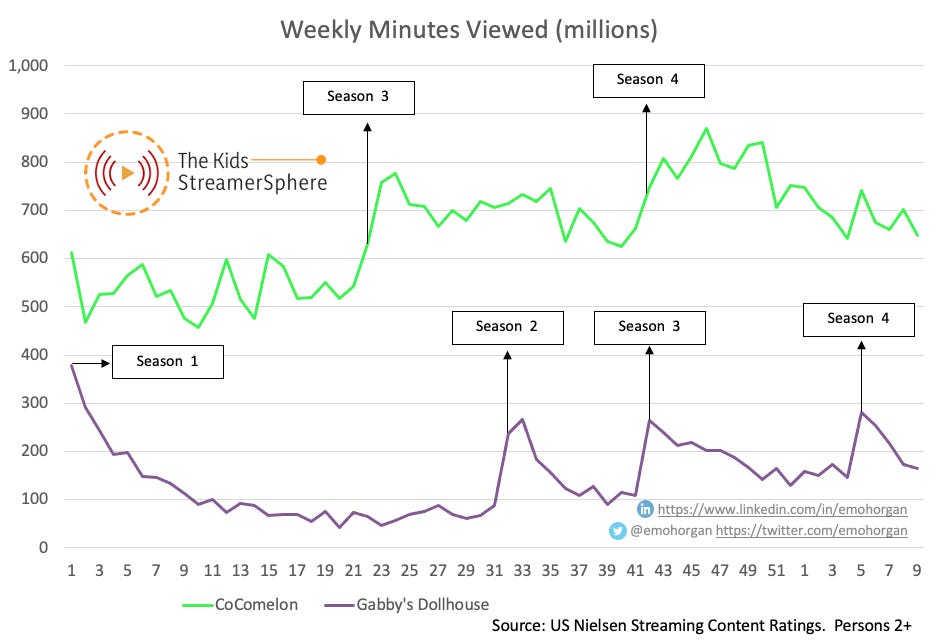Netflix Preschool Series: What Does a Hit Look Like?
This issue of The Kids StreamerSphere was supposed to unpack data that enlightens us on what constitutes a hit for preschool content in streaming. HOWEVER! First, a timely and relevant follow-up story that’s emerged since the latest Netflix earnings call.
‘Dino Daycare’ Axed at Netflix
Turns out Chris Nee’s show of public support for the Netflix Kids and Family division, mentioned in the last edition of this newsletter, was twice as classy as it appeared. She had risen above the chaos despite the fact that one of her shows, Dino Daycare, was about to be put on the Netflix chopping block.
Nee joined Netflix Animation in 2018 following a hugely successful run at Disney Junior where she created platform-defining franchises like Doc McStuffins and Vampirina. Her statement on the series axing is worth reading in full, but the kicker for me is:
“As we worked to address Netflix’s concerns in terms of it finding an audience on their platform, the father son relationship was dismantled and the more simplistic storylines that Netflix felt they needed ended up eroding the basic message.”
First of all, what does “finding an audience” mean at Netflix? There’s been lots of discourse recently around the type of performance Netflix want to see. 7-day and 28-day benchmarks that indicate “starters,” “watchers,” and “completers” have long been part of their performance vernacular. These are the standard numbers shared with content creators. But can you apply these measures at broad scale across all content genres, most importantly kids?
Secondly, how simplistic do Netflix feel they need to go with preschoolers? Call me crazy, but “simple”—at least in my mind—immediately screams YouTube content, and we know CoComelon has seen a stunning run of success on the platform. That’s not to say that shows like Peppa Pig wouldn’t also fit the bill.
What Data Do We Have?
Available metrics that can give a sense of what’s hot include:
1. Netflix Global Hours Viewed: Rankings of hours viewed released weekly on the Netflix Global Top 10 site. This, seemingly radical, data disclosure isn’t as helpful as it sounds. Series are counted on a season level, which makes incremental uplift hard to see; they’ll also favor content with a longer duration. Numbers should be somewhat comparable to the 7- and 28-day releases you’ll receive from Netflix if you’re producing content for them, but get a professional to do the crunching for you.
2. U.S. Nielsen Streaming Content Ratings: Released weekly at the Nielsen website, covering U.S. minutes viewed across Amazon Prime, Disney+, Hulu, and Netflix. These look at content across three separate categories: Originals, Acquired, and Movies.
3. Trending Top 10s: Details of these are also released by Netflix on their Global Top 10 site, but the broader picture across platforms is also tracked, alongside lots of other helpful measures by FlixPatrol. Given Trending Top 10s lack any contextual measurement, it’s fair to say that they are a less quantifiably scientific indicator.
What Can We See for Preschool Series?
As touched on above, if there’s one show that’s dominated kids headlines for Netflix performance in the last two years, it’s CoComelon. To be fair, the hype generally checks out. Epic runs in the Trending Top 10s for the U.S. were initial indicators of the show’s undeniable success (and closer to my heart, though less statistically significant, Ireland also generously represents the CoComelon Trending Top 10 love). Having said that, a recent deep dive from Kasey Moore at What’s on Netflix shows that, although the show ranks very respectably, it’s actually 3rd in terms of Global Trending Top 10s. Preschool dominates the top five here, with CoComelon (#3) bested by streaming original Gabby’s Dollhouse (#2), both sandwiched between long-established franchises Peppa Pig (#4) and ultimate winner PAW Patrol (#1).
U.S. Nielsen Streaming Content Ratings give another point of view. The fascinating thing about CoComelon’s performance here is the more content that’s added, the more viewing clocks up. Intuitively, it would be reasonable to consider the time a preschooler sits in front of the telly to be finite, with a fresh batch of their favorite show holding some appeal for parents who go insane listening to the same thing. But to me, that doesn’t fully explain the net-net uplift CoComelon sees in the U.S. with every new content drop (alternative answers very welcome—drop a message or comment).
When we look at how Gabby’s Dollhouse is building, in conjunction with the ongoing success of CoComelon, we get a sense of the real binge-ability value for kids. This applies in the build of a show, when it evolves from a once-off sample to an everyday staple. And these figures aren’t going to show at 7 and 28 days; the proof will be in the proverbial pudding over a longer period of time. Gabby’s Dollhouse has had a stunning first year of performance overall, and is shaping up to be the next streaming original franchise.
What Can We Tell from the Netflix Global Hours Viewed?
As whined about above, the Netflix Global Hours Viewed tell us fierce little. We can definitively say that CoComelon has the strongest featuring in this ranking of any kids show, with observable peaks around season premieres. Beyond that, we just need to keep sifting on series premiere week performance as it comes through (just like we did in the previous newsletter).
So Where Does That Leave the Chris Nee Slate?
Bringing it back to the axing of Dino Daycare, what we can say is other Netflix shows that launched this year from Chris Nee are yet to ping any of the above tracked metrics. Ridley Jones and Ada Twist, Scientist failed to cut through in either U.S. Nielsen Streaming Content Ratings or Netflix Global Top 10s, with minimal performance seen in Trending Top 10s. That doesn’t mean they didn’t perform at all, these publicly available rankings are the shark fins of the full story.
We do know that Ridley Jones had a big promotional push on YouTube, with the first episode premiering there, alongside a generous marketing spend. Nee has a proven track record, though this is in telling beautiful, multilayered stories that matter, and evidently not the simple story lines Netflix are looking for.
How simple do Netflix want to take these? Well, they aren't going to be served regurgitating YouTube. Preschool concepts that are perfectly simple are harder to find than it might sound. I'd say the closest successor to Peppa Pig is arguably Bluey, though hit me in the comments with other suggestions. The wait between these two was a mere 14 years(!).
Other factors might very well be at play too. Discoverability is one reason former kids creators at Netflix are frustrated: once you’re off the front page you’re a search away—clear barriers for preschoolers there. Also, how can algorithmic recommendation accommodate a slow and steady audience build that we all know is often needed with kids IP?
Another thing that both CoComelon and Gabby’s Dollhouse have is a well-oiled franchise flywheel pushing the momentum of the IP on touchpoints beyond Netflix. Could Netflix crew up to light this spark? Sure. Though this is another area that requires both patience and build, plus my guess is that they’re currently pretty tied up sorting out their AVOD offering by the end of this year.





